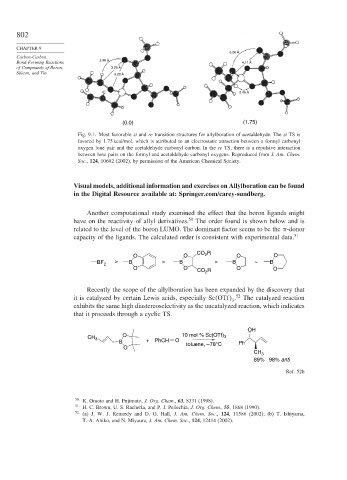Page 826 - Advanced Organic Chemistry Part B - Reactions & Synthesis
P. 826
802
CHAPTER 9
3.26 Å
Carbon-Carbon
2.90 Å
Bond-Forming Reactions 4.11 Å
of Compounds of Boron, 3.28 Å
Silicon, and Tin 3.20 Å
2.45 Å
(0.0) (1.75)
Fig. 9.1. Most favorable si and re transition structures for allylboration of acetaldehyde. The si TS is
favored by 1.75 kcal/mol, which is attributed to an electrostatic attraction between a formyl carbonyl
oxygen lone pair and the acetaldehyde carbonyl carbon. In the re TS, there is a repulsive interaction
between lone pairs on the formyl and acetaldehyde carbonyl oxygens. Reproduced from J. Am. Chem.
Soc., 124, 10692 (2002), by permission of the American Chemical Society.
Visual models, additional information and exercises on Allylboration can be found
in the Digital Resource available at: Springer.com/carey-sundberg.
Another computational study examined the effect that the boron ligands might
have on the reactivity of allyl derivatives. 50 The order found is shown below and is
related to the level of the boron LUMO. The dominant factor seems to be the -donor
capacity of the ligands. The calculated order is consistent with experimental data. 51
CO R
O O 2 O O
BF 2 > B > B > B ~ B
O O O O
CO 2 R
Recently the scope of the allylboration has been expanded by the discovery that
it is catalyzed by certain Lewis acids, especially Sc OTf . 52 The catalyzed reaction
3
exhibits the same high diastereoselectivity as the uncatalyzed reaction, which indicates
that it proceeds through a cyclic TS.
OH
CH 3 O 10 mol % Sc(OTf) 3
B + PhCH O toluene, – 78°C Ph
O
CH 3
89% 98% anti
Ref. 52b
50 K. Omoto and H. Fujimoto, J. Org. Chem., 63, 8331 (1998).
51 H. C. Brown, U. S. Racherla, and P. J. Pellechia, J. Org. Chem., 55, 1868 (1990).
52
(a) J. W. J. Kennedy and D. G. Hall, J. Am. Chem. Soc., 124, 11586 (2002); (b) T. Ishiyama,
T.-A. Ahiko, and N. Miyaura, J. Am. Chem. Soc., 124, 12414 (2002).

